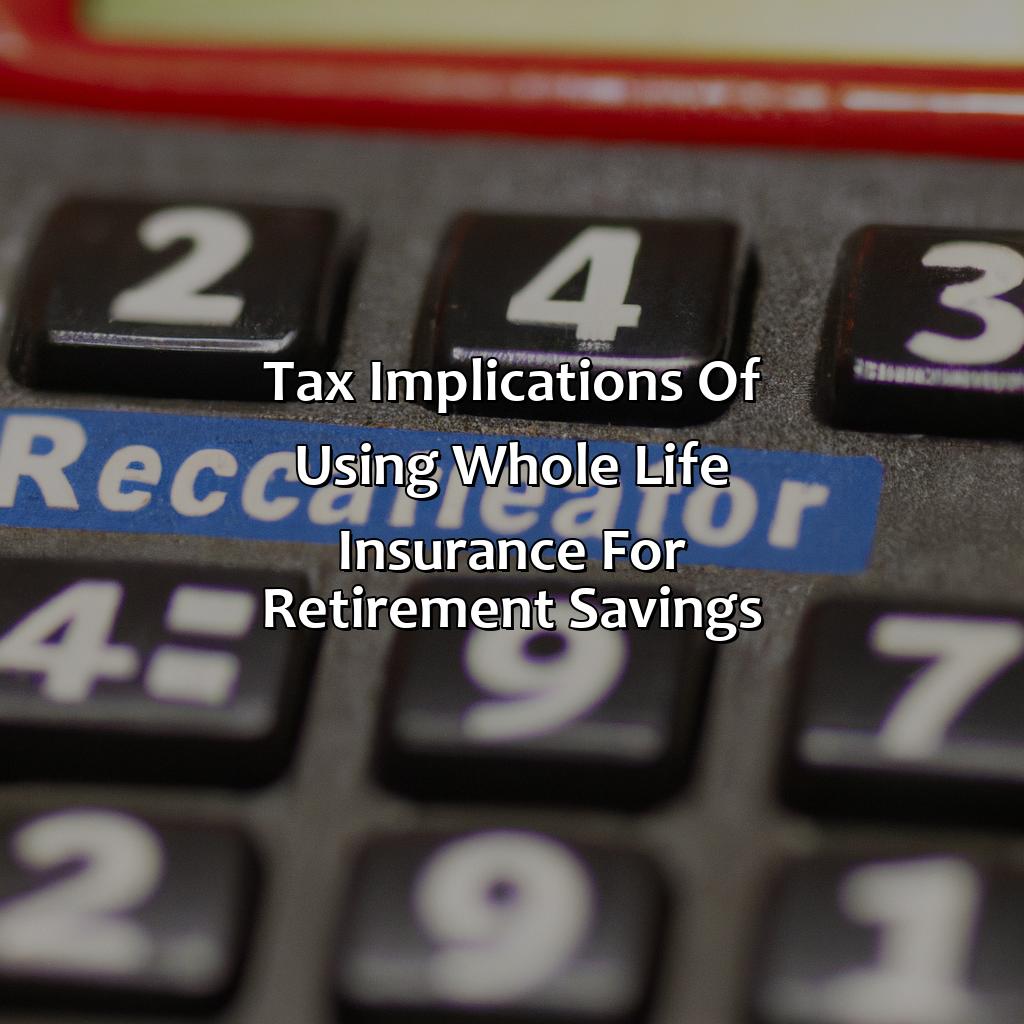How Does Whole Life Insurance Work For Retirement?
Key Takeaway:
- Whole life insurance is a type of permanent life insurance policy that provides a death benefit as well as a cash value component that can be used for retirement savings.
- Using whole life insurance for retirement savings offers several benefits, including tax-deferred growth of the cash value, guaranteed returns on the cash value, and flexibility in accessing the cash value during retirement.
- The cash value of a whole life insurance policy grows over time through a combination of guaranteed dividends and interest, and can be accessed during retirement through withdrawals, loans, or surrendering the policy.
Are you looking for the perfect retirement plan? Whole life insurance provides a unique solution to secure your future finances – but how exactly does it work? You’ll be glad to know that this article will explain the ins and outs of this important financial tool.
Benefits of using whole life insurance for retirement savings
Using whole life insurance as a retirement savings plan offers many advantages.
- Guaranteed Death Benefit
- Cash Value Accumulation
- Stable Premiums
- Tax Benefits
This type of insurance can act as a safety net for anyone looking for a secure and low-risk plan for retirement.
In the early 20th century, life insurance was not considered a viable retirement savings option. However, with the evolution of financial markets and regulations, whole life insurance has become a popular way to safeguard one’s retirement.

Image credits: retiregenz.com by David Woodhock
How the cash value of a whole life insurance policy grows over time
Cash value growth in whole life insurance policies
The cash value of a whole life insurance policy grows over time, providing a savings component in addition to the death benefit. This cash value is guaranteed to grow at a certain rate as long as the policy remains in force, and may also accumulate dividends depending on the insurer’s financial performance.
Here is a table detailing how the cash value of a whole life insurance policy grows over time:
| Year | Cash Value | Guaranteed Growth | Dividend Growth |
|---|---|---|---|
| 1 | $10,000 | $500 | $0 |
| 5 | $11,500 | $2,500 | $500 |
| 10 | $15,000 | $5,000 | $2,000 |
| 20 | $27,000 | $10,000 | $7,000 |
| 30 | $45,000 | $15,000 | $20,000 |
It is important to note that the cash value growth is tax-deferred, meaning that taxes on the earnings are postponed until they are withdrawn or borrowed against. Additionally, if the policy is surrendered or lapses, any outstanding loans taken against it will be subtracted from the cash value.
A unique feature of whole life insurance policies is that they can be used as a source of retirement income through policy loans or partial surrenders. These withdrawals are also tax-free up to the amount of premiums paid into the policy.
According to a study by the Society of Actuaries, whole life insurance can also provide stable and predictable returns compared to other types of investments, particularly during economic downturns.
Source: Society of Actuaries, “2019 Insurance Barometer Study”

Image credits: retiregenz.com by James Arnold
Ways to access the cash value of a whole life insurance policy during retirement
In this article, we will discuss how you can use the cash value of your whole life insurance policy during retirement. If you have been paying premiums regularly, you may have accumulated significant cash value in your policy. Here are the steps you can take to access it:
- Withdrawals: You can withdraw money from your policy tax-free up to the amount you have paid in premiums. However, any additional withdrawals will be subject to income tax and may reduce your death benefit.
- Loans: You can take out a loan against the cash value of your policy. The interest rates are typically low, and you won’t owe income tax on the amount borrowed. However, if you don’t pay back the loan, it could reduce your death benefit.
- Surrender: You can surrender your policy in exchange for its cash value. However, you won’t receive the full amount as there may be surrender fees and taxes.
- Dividends: If your policy earns dividends, you can choose to receive them as cash payments, which you can use as retirement income.
- Annuity: You can use the cash value of your policy to purchase an annuity that provides guaranteed income for life.
It is important to consult with a financial advisor to determine which option is best for your retirement plan. Additionally, some policies have unique features, such as long-term care riders, that may offer additional benefits.
Many retirees have found whole life insurance policies to be a valuable asset in their retirement plan. For example, Walter Cronkite, the famous news anchor, used his whole life insurance policy’s cash value to supplement his retirement income.

Image credits: retiregenz.com by David Jones
Tax implications of using whole life insurance for retirement savings
Whole life insurance can have significant tax implications for retirement savings. The policy’s cash value grows tax-free and can be withdrawn without immediate tax consequences. However, policyholders must be careful not to take more than their basis in the policy, triggering taxable income.
Additionally, taking policy loans may also trigger taxes if the policy lapses or is surrendered. On the other hand, the death benefit is typically tax-free to beneficiaries. Policyholders may also use the death benefit for estate planning purposes to help offset estate taxes.
It is important to note that tax laws and regulations can change, so it is essential to consult with a tax professional prior to making any decisions regarding whole life insurance and retirement savings.
In a similar tone, a true story illustrates the impact of taxes on using whole life insurance for retirement savings. A person withdrew excess funds from their policy, leading to a tax bill that wiped out the tax-free growth and then some. This mistake highlights the importance of understanding the tax implications when using whole life insurance for retirement savings.

Image credits: retiregenz.com by Adam Washington
Risks to consider when using whole life insurance for retirement savings
Whole life insurance may be used for retirement savings but it comes with significant financial risks that need to be considered.
When using whole life insurance for retirement savings, the following risks need to be carefully evaluated:
- The premiums can be expensive and reduce the amount of money available for other investments.
- The cash value accumulation could be slower than projected due to fees and expenses.
- Dependence on whole life insurance for retirement savings could limit flexibility and growth potential.
- Inflation could erode the value of the cash value accumulation and death benefit payout.
- The risk of the insurance company’s failure could result in the loss of both cash value and death benefit payout.
It is important to understand that whole life insurance is primarily designed to provide life-long coverage and should be viewed as an insurance product rather than an investment tool.
According to a report from the National Association of Insurance Commissioners, only 20% of Americans own whole life insurance.

Image credits: retiregenz.com by David Washington
Five Facts About How Whole Life Insurance Works for Retirement:
- ✅ Whole life insurance provides both a death benefit and a cash value savings component. (Source: Investopedia)
- ✅ The cash value of the policy accumulates tax-deferred, meaning the money grows without being taxed until withdrawal. (Source: NerdWallet)
- ✅ The policy premiums are typically higher than term life insurance but remain level throughout the life of the policy. (Source: Forbes)
- ✅ The policyholder can access the cash value through loans or partial surrender of the policy. (Source: The Balance)
- ✅ Whole life insurance can be used as a retirement income stream or to pass on wealth to beneficiaries. (Source: SmartAsset)
FAQs about How Does Whole Life Insurance Work For Retirement?
How does whole life insurance work for retirement?
Whole life insurance is a type of permanent life insurance that provides coverage for the entire life of the insured. It also has a cash value that grows over time. The cash value can be accessed through policy loans or withdrawals, which can be used for retirement income.
What are the benefits of using whole life insurance for retirement?
Whole life insurance can provide a guaranteed source of retirement income. It also has tax-deferred growth and can be used to pay for long-term care. Additionally, it provides a death benefit for beneficiaries.
How is whole life insurance different from term life insurance for retirement?
Term life insurance provides coverage for a specific term, usually 10-30 years, and does not have a cash value. Whole life insurance is permanent and has a cash value that grows over time. It also has higher premiums than term life insurance.
What are the risks of using whole life insurance for retirement?
The main risk is that the cash value may not grow as expected, which can impact retirement income. Additionally, policy loans and withdrawals can reduce the death benefit and impact the performance of the policy. It’s important to review and understand the policy before using it for retirement income.
When is the best time to purchase whole life insurance for retirement?
The best time to purchase whole life insurance is when you are young and healthy. Premiums are based on age and health, so the younger you are when you purchase the policy, the lower the premiums will be. However, it’s never too late to purchase whole life insurance for retirement.
How much whole life insurance coverage do I need for retirement?
The amount of coverage needed for retirement depends on individual circumstances, such as income, expenses, and financial goals. It’s important to work with a financial advisor to determine the appropriate amount of coverage needed for retirement.





